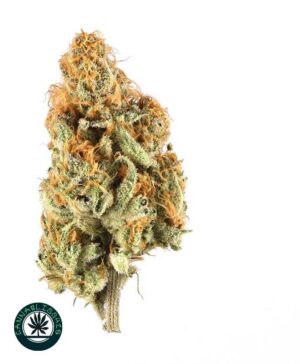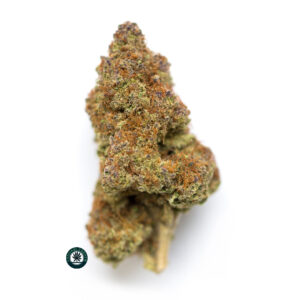Strawberry Cough is a beloved sativa-leaning cultivar known for an unmistakable sweet, berry-forward aroma and clean, fruit-forward smoke that many Aussies recognise the moment the jar opens.
This sativa-dominant hybrid favours clear-headed, uplifting effects over heavy sedation, making it a top pick for daytime sessions and social catch-ups. Typical THC sits around 15–20%, with some phenotypes testing higher, delivering a bright, cerebral buzz.
The name hints at its lively profile and easygoing experience. Origin stories point to Kyle Kushman and a clone-only cut from 1999 in Bridgeport, Connecticut that helped the strain spread across the US and onward to global acclaim.
Growers praise a terpene mix led by terpinolene, myrcene and pinene, plus moderate flowering (9–11 weeks) and generous yields when trained and lit well indoors or given a sunny outdoor spot.

Key Takeaways
- Profile: Sweet, berry aroma with clean, fruit-forward smoke.
- Effects: Uplifting, cerebral buzz suited to daytime use.
- Potency: Commonly 15–20% THC; some phenotypes higher.
- Origins: Clone-only cut linked to Kyle Kushman, 1999.
- Grow tips: Flowers 9–11 weeks; generous yields in good conditions.
- Audience: Great for creative, social and clear-headed users.
Strawberry Cough at a glance: a sativa‑dominant hybrid with uplifting effects
Fans reach for this strain when they want a creative push and a clean, cerebral lift.
This sativa-dominant hybrid typically tests around 15–20% THC and gives a buzzy, cerebral high that feels energetic and social. The top-line effects are euphoric, creative and sociable — perfect for daytime productivity without heavy sedation.
The aroma and flavour lean intensely berry-forward with light spice, backed by terpinolene, myrcene and pinene. These terpenes help explain the bright mood and lively, clear-headed experience that many users praise.
- Who benefits: people after focus, creativity or social energy.
- THC: ~15–20% — lively but manageable with sensible dosing.
- Notes: common side effects include dry mouth and dry eyes; larger doses may cause dizziness or anxiety for some.
As a popular cannabis strain for daytime sessions, the cough strain’s cheerful characteristics and memorable aroma make it an easy recommendation among comparable sativa options. We’ll next unpack how that nose turns into flavour and why the terpene mix supports its mood profile.
Origins and genetics: Haze x Strawberry Fields and the Kyle Kushman connection
The accepted lineage pairs classic Haze vigour with the fragrant fruitiness of Strawberry Fields.
Haze provides the sativa backbone here — a lineage known for energy, focus and a clear head. Those landrace roots explain much of the strain’s uplifting characteristics.

Strawberry Fields influence
Strawberry Fields brings the ripe, berry aroma and denser buds. Its indica traits soften the high and add a sweet nose that many recognise instantly.
Kyle Kushman’s role
“A clone-only cut shared in Bridgeport, 1999, helped the cultivar spread rapidly.”
Kyle Kushman received and distributed clones, which fuelled popularity across the US and beyond.
Why the exact parentage remains fuzzy
Despite the commonly cited cross, precise records are sparse. Different varieties and phenotypes shift terpene balance, so aromas and effects can vary.
- Simple takeaway: genetics shape both aroma and core characteristics.
Aroma, flavour and terpene profile: sweet berry notes with a fresh field vibe
Aroma leaps forward the moment you open a jar. A vivid, sweet bouquet of ripe fruit and sun-warmed leaves fills the air. The scent often reads like jammy compote with a fresh, field-like top note.

Dominant terpenes
Terpinolene gives a bright, citrusy lift. Myrcene layers fruity depth and smoothness. Pinene adds crisp, pine-like clarity.
Taste and nose
The taste follows the nose: ripe-strawberry sweetness up front with a touch of earth and light spice on the finish. Cured buds can smell like strawberry jam or fresh compote, a signature many fans seek.
- Profile drivers: terpinolene = lift, myrcene = depth, pinene = snap.
- As a friendly hybrid, the flavour feels like a classic dessert strain—smooth and moreish.
- Try vaping at moderate temps to highlight the bright, fruit-forward notes.
| Terpene | Primary role | Perceived effect |
|---|---|---|
| Terpinolene | Top note | Uplift, fresh aroma |
| Myrcene | Body | Fruity depth, smoothness |
| Pinene | Accents | Clarity, crisp finish |
Batch variation happens—some phenos lean floral or piney depending on drying and cure. Trust your nose: aroma is a reliable guide to fresh, quality buds and the likely effects of your chosen jar.
Effects and potency: bright, cerebral high without the couch‑lock
Users often report a bright, cerebral high that arrives fast and keeps the body light.
On‑ramp: Expect a swift mood shift and mental lift that nudges creativity and chat. The on‑ramp is more head-first than heavy, so activity feels natural rather than taxing.
Recreational experience
The strain works well for daytime plans — walks, markets or catching up with mates. Its energetic, sociable character helps spark ideas and conversation without couch‑lock.
Potential therapeutic uses
Many users turn to it for mood elevation and focus support during mentally engaging tasks. Mild indica notes can also bring a modest appetite boost for some.
Common side effects
Dry mouth and dry eyes are the most reported issues. Sensitive users may notice dizziness, anxiety or headaches at higher doses. Start low, go slow.
THC expectations
Typical THC sits around 15–20%, giving a lively, long‑lasting lift. Sensible dosing and hydration keep the experience productive and pleasant.
- Sensible tip: try a calm setting for first tries and sip water.
- Match dosing to plans — smaller amounts for focus, slightly more for social or creative sessions.
Growing Strawberry Cough in Australia: climate, training and yields
Australian growers get the best from this sativa-leaning strain by pairing warm, Mediterranean-like conditions with steady canopy control.

Best climates and site choices
Parts of SA, WA, coastal NSW and SE QLD suit the cultivar well. Cooler or wetter zones should consider greenhouse cover to protect plants late in the season.
Indoor tips: light and training
Bright, consistent light is key. Keep heights around 120–150cm indoors and use topping, LST and ScrOG to tame stretch and even the canopy.
Outdoor considerations and mould prevention
Outdoors the priority is airflow and dry conditions as buds mature. Vigilant IPM, staking and selective defoliation cut botrytis risk during the wet months.
Timing, yields and harvest
Flowering runs roughly 9–11 weeks depending on phenotype. Indoor yields often hit 550–600 g/m² with dialled-in training.
Outdoor plants can return 700+ g/plant in warm, full-sun sites. In southern Australia aim for a mid to late October harvest, watching trichomes and pistils to pick peak ripeness.
Final grow notes
Expect plant heights of about 120–150cm indoors and 150–180cm+ outdoors. Patient, steady care rewards you with fragrant, resinous buds and a high-quality result from this popular cough strain.
Strawberry Cough variations and buying tips: feminised vs automatic
Two clear options suit different growers: a larger photoperiod plant for high output, or a fast, compact auto for tight spaces. Pick the version that matches your space, schedule and final goals before you buy.

Feminised plants stretch more and respond well to training. Expect heights of about 120–150cm indoors and 150–180cm outdoors.
Indoor yields typically hit 550–600 g/m², with outdoor plants often returning 700+ g/plant. Potency usually measures around 19–20% THC, making this variety ideal for growers chasing higher output and stronger effects.
Automatic option for faster harvests
Automatic or autoflowering lines finish quickly — roughly 10–11 weeks seed to harvest. They stay compact (around 110–150cm) and suit small spaces or growers who want a faster turnaround.
Autos yield around 450–550 g/m² indoors or about 80–120 g/plant outdoors. Potency is typically near 15% THC but the taste and berry aroma remain intact.
| Feature | Feminised | Automatic | Grower fit |
|---|---|---|---|
| Height | 120–150cm (in), 150–180cm+ (out) | 110–150cm | Space vs speed |
| Indoor yields | 550–600 g/m² | 450–550 g/m² | High output vs compact returns |
| Outdoor yields | 700+ g/plant | 80–120 g/plant | Full-season vs quick cycles |
| THC / potency | ~19–20% THC | ~15% THC | Power vs accessibility |
Buying tips
- Choose feminised for maximum yields, training flexibility and higher potency.
- Pick autos for simplicity, speed and limited space; avoid heavy training on autos to protect timelines.
- Check breeder notes for genetics and flowering weeks to match your climate and schedule.
Overall, the best choice depends on your setup. The combination of variety and training will guide results, so match your goals and enjoy a reliable, berry-forward taste from either version when growing strawberry cough.
Who should choose Strawberry Cough? Users, occasions and ideal use cases
If clarity and a chatty mood are the brief, this sativa-leaning option often delivers. It suits people after a light, upbeat headspace rather than heavy sedation.

Daytime clarity, creative sessions and easygoing social settings
Recommended choice for users who want a clear, upbeat headspace for work, study, art or music without heavy body drag.
The typical experience includes euphoria, focus and sociability. Those effects make this strain a go-to for daytime tasks and creative sessions.
Good occasions: weekend markets, beach walks or relaxed BBQs where a friendly, talkative buzz fits the plan. The sweet strawberry aroma enhances the sensory experience for many consumers.
- Why pick it: crisp focus and a cheerful mood for brainstorming or collaboration.
- Approachability: uplifting effects and moderate potency suit users easing into sativa options.
- Sensible tip: start low to dial in comfort, especially for sensitive users.
Compared to heavier cultivars, this strain stands out when clarity matters over couch time. The name has become shorthand among friends for a bright session that keeps conversation flowing.
Final thought: as a versatile choice in any rotation, strawberry cough is ideal for everyday lift, creativity and easy social moments when set and setting match the plan.
Conclusion
Conclusion
Few modern cultivars balance day-ready energy and dessert-like aroma as neatly as this sativa-leaning classic. The strawberry cough strain blends likely Haze x Strawberry Fields origins with a jammy, fruit-forward aroma and a bright, cerebral lift that suits creative and social plans.
Credit goes to Kyle Kushman for spreading the clone-only cut that helped the cultivar find its place. Expect sweet berry notes with light spice from a terpene mix that keeps the experience fresh and focused.
Growers: plan for 9–11 weeks of flowering, strong light and good airflow for dense buds. Aussies should match climate or use greenhouse cover for the best results. Start low on dosing, then build to your ideal social or solo groove, and choose feminised for yield or auto for speed.
FAQ
What is Strawberry Cough and how would you describe it?
Strawberry Cough is a sativa‑dominant hybrid known for a bright, cerebral high and a sweet berry aroma. Users report an uplifting, energetic buzz that suits daytime activities, creative work and socialising rather than heavy relaxation or couch‑lock.
What are the known genetics behind this strain?
Its lineage traces to a Haze cross with a variety called Strawberry Fields, combining Haze’s cerebral heritage with berry‑forward characteristics. Exact parentage remains debated, and Kyle Kushman helped popularise several well‑known clone cuts that carried the name.
Which terpenes shape the aroma and flavour?
The profile leans on terpinolene, myrcene and pinene, producing sweet fruit notes with a fresh, field‑like lift and a subtle spicy finish on the exhale.
What effects can users typically expect?
Expect an energetic, clear‑headed high that enhances focus, creativity and sociability. It’s often chosen for daytime use when mental sharpness matters rather than sedation.
Are there therapeutic benefits associated with this cultivar?
Some patients use it for mood elevation, improved focus and to stimulate appetite. Its stimulating properties may help mild depression or fatigue, though responses vary between individuals.
What common side effects should I be aware of?
Dry mouth and dry eyes are the most frequent effects. Some users may experience mild dizziness or anxiety, particularly at higher doses or with low tolerance.
How potent is it — what THC range is typical?
Potency often sits in the mid to high teens percentage-wise, commonly around 15–20% THC. Phenotypes and growing conditions can push levels higher or lower.
Is it easy to grow in Australia and which climates suit it best?
It thrives in sunny, Mediterranean‑like zones and performs well in greenhouses. Coastal and inland temperate regions with long, dry finishes are ideal to avoid late‑season mould.
What indoor techniques help manage its sativa stretch?
Topping, low‑stress training (LST) and a ScrOG setup control vertical stretch and improve canopy light distribution, helping boost yields while keeping height manageable.
What should outdoor growers watch for late in the season?
Monitor humidity and airflow to prevent mould as buds fatten. Choose a well‑drained, sun‑exposed site and harvest before prolonged wet periods to protect quality.
How long does flowering take and when is harvest time?
Flowering typically runs about 9–11 weeks depending on phenotype. Outdoors in suitable Australian zones, expect harvest from mid to late October for best resin and terpene development.
What yields can growers expect indoors and outdoors?
Indoor results often reach about 550–600 g/m² with optimized conditions. Outdoors, well‑grown plants can exceed 700 g each, though genetics and care significantly influence totals.
What are the differences between feminised and automatic versions?
Feminised plants tend to grow taller, produce larger yields and often show higher THC. Automatic (autoflower) versions finish faster — around 10–11 weeks seed to harvest — and stay compact, suiting discreet or space‑limited grows.
Who is the ideal user for this strain?
It suits daytime users, creative types and people seeking social, focused experiences. Those who want a stimulating lift without strong sedative effects will likely prefer it.
Any tips for choosing a source or phenotype when buying?
Look for reputable breeders or licensed suppliers that list terpene and cannabinoid profiles. Ask about lineage, grow notes and whether the cut leans more toward Haze or the berry side to match your desired effects.







